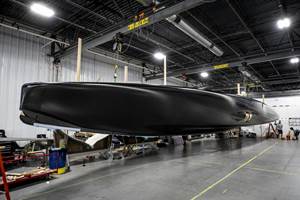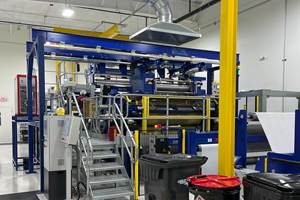Cast polymer concrete structures save city's sewers
Beneath its historic colonial charm, Charleston, S.C. had an underground sewer system in need of repair. Engineers at U.S. Composite Pipe (Alvarado, Texas) devised a solution that included unique cast polymer composite sewer interceptor structures — 10-ft/3m-diameter vertical access shafts that extend as far as 110
Beneath its historic colonial charm, Charleston, S.C. had an underground sewer system in need of repair. Engineers at U.S. Composite Pipe (Alvarado, Texas) devised a solution that included unique cast polymer composite sewer interceptor structures — 10-ft/3m-diameter vertical access shafts that extend as far as 110 ft/33.5m below ground. The structures combine the strength of steel-reinforced concrete with the performance and corrosion resistance of composites. AOC LLC (Collierville, Tenn.) supplied its trademarked Vipel corrosion-resistant isophthalic polyester resin for the project.
The composite installation was part of a major sanitary sewer rehabilitation project, designed and engineered by consulting engineers Black & Veatch (B&V; Charleston, S.C.). The interceptor structures were contracted to Affholder Inc., a subsidiary of Insituform Technologies Inc. (Chesterfield, Mo.). Affholder, in turn, subcontracted fabrication of the composite parts for the project to U.S. Composite Pipe.
To make the large pipe sections, a mixture of a proprietary Vipel polyester resin formulation, a filler, aggregate material and an additive mixture licensed from PPT LLC (Des Moines, Iowa) was cast in a procedure similar to conventional concrete pipe. U.S. Composite Pipe manufactured the sections by first placing a steel reinforcement bar “cage” into a form made of steel (see photo). As it does in conventional concrete pipe, the steel cage gives the finished polymer concrete product the ability to handle compression and tensile loading. The polymer concrete then was vertically cast into the formwork and vibrated to remove air that could cause voids in the finished pipe.
At the base of each shaft at the work site, U.S. Composite Pipe used the same Vipel resin-based composite to manufacture a foundation floor as well as a vortex chamber with baffle wall to help control sewage flow. Each sewer interceptor shaft was installed by stacking cast cylindrical composite riser sections up from the foundation floors. Joints between sections were accomplished using steel end ring fittings that U.S. Composite Pipe integrally manufactured into the cast structures. These special joint rings conform to American Water Works Assn. (AWWA) C-302 standards for air and water tightness and were tested to 50 psi/3.5 bar.
Dan Swidrak (now with Independent Concrete Pipe, Indianapolis, Ind.) was the onsite project engineer for Affholder. He says the polymer concrete structures had several advantages over those made from traditional steel-reinforced concrete. “Because the composite pipe was precast and ready to install upon arrival, it took weeks off installation time,” says Swidrak. “With conventional concrete, additional time would have been needed to pour the material in place, wait for it to cure, clean and prepare the surface, then apply a protective epoxy liner.” Protective epoxy liners require regular inspection and maintenance, he notes, and if the liner is abraded or damaged, the concrete and the reinforcing steel are exposed to corrosive sewer gas. In this case, the inherent corrosion resistance of the polymer concrete eliminated the need for a protective liner, saving labor and material costs.
An unexpected advantage of the use of high-performance polymer concrete was the opportunity to significantly reduce the overall weight of the structures. Although polymer concrete has nearly the same unit weight as Portland cement concrete, the polymer’s mechanical performance, pound-for-pound, is superior. Eric H. Davidson, P.E., vice president of U.S. Composite Pipe, says, “We took the original design from B&V and were able to reduce the wall thickness by 40 percent or more through our own in-house engineering and design.” The benefits of this refined design cascaded through the construction process: Use of less material reduced the overall cost of the finished product. It cost less to ship the lighter structures to the job site, and the structures were lowered into position on site using a smaller than anticipated and, therefore, less expensive, crane.
Further, the Vipel polymer formulation, when compared to cementitious binder, provided improved compressive, tensile, shear, bonding and flexural properties. These high-strength characteristics helped engineers meet the project’s performance specifications, an especially important outcome because Charleston is located in a seismically active region.
According to Davidson, the Vipel resin technology comes with excellent technical support. “We are part of a company that has more than 20 years’ experience making pipe with conventional concrete,” Davidson said. “When we started developing composite materials, AOC representatives were on hand to help us. Now we have a resin formulation that we just ‘dial in’ to make polymer concrete.”
Related Content
Pro-Set named official materials supplier for New York Yacht Club American Magic
Competitive sailing team prepares for the 37th America’s Cup beginning in August 2024 with adhesives, resins and laminate testing services for its AC75 monohull construction.
Read MoreEpoxy-based structural film adhesive intended for aerospace, MRO
CAMX 2023: Park Aerospace is presenting its new aerospace-grade film adhesive material Aeroadhere FAE-350-1, in addition to other product offerings intended for aerospace, defense and spacecraft.
Read MoreXlynX Materials BondLynx and PlastiLynx for low surface energy PP, PE substrates
Award-winning Xlynx materials use breakthrough “diazirine” technology to boost bond strength up to 950% as adhesives, primers and textile strengtheners.
Read MoreSyensqo introduces AeroPaste 1003 aerospace adhesive
Two-part room-temperature paste increases high-rate assembly and joining efficiencies when bonding metallic and composite parts.
Read MoreRead Next
CW’s 2024 Top Shops survey offers new approach to benchmarking
Respondents that complete the survey by April 30, 2024, have the chance to be recognized as an honoree.
Read MoreComposites end markets: Energy (2024)
Composites are used widely in oil/gas, wind and other renewable energy applications. Despite market challenges, growth potential and innovation for composites continue.
Read MoreFrom the CW Archives: The tale of the thermoplastic cryotank
In 2006, guest columnist Bob Hartunian related the story of his efforts two decades prior, while at McDonnell Douglas, to develop a thermoplastic composite crytank for hydrogen storage. He learned a lot of lessons.
Read More





















